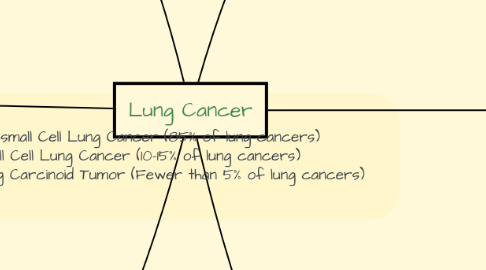
1. Pathophysiologic Etiology
1.1. Chronic inflammatory conditions (such as asthma) increase cancer risk. Lung cancer arises from respiratory epithelium. May be a response to a variety of risk factors that increase the potential of lung cancer, such as smoking, second hand smoking, and genetic factors. Lung cancer tumors alter the immune system and are considered a hallmark of cancer. Lung tumors arise from chronic inflammation sites, filled with leukocytes, cytokines, chemokines, growth factors, and matrix-degrading enzymes. Tumor cancer cells are genetically different than the remaining cells. Tumor-infiltrating leukocytes have tumor suppressing or tumor protecting effects. Thus, they proliferate without any “stop” signal in their genetics. CTLA-4 and cell death protein 1 are cytokines and immune checkpoints thought to be used to protect lung carcinomas- CTLA-4 blocking antibody with chemo revealed that squamous LC had great clinical benefits. Tumor promotes tumor associated macrophages (TAM) prevent immune system from creating anti-tumoral response.
2. Common Findings
2.1. General
2.1.1. Cough that does not go away or gets worse Coughing up blood or rust-colored sputum (spit or phlegm) Chest pain that is often worse with deep breathing, coughing, or laughing Hoarseness Weight loss and loss of appetite Shortness of breath Feeling tired or weak Infections such as bronchitis and pneumonia that do not go away or keep coming back New onset of wheezing
2.2. Metastasized Lung Cancer Findings
2.2.1. Bone pain Nervous system changes (headache, weakness, numbness of an extremity, dizziness, seizures) Yellowing of skin and/or eyes Lumps near the surface of the bodyBone pain Nervous system changes (headache, weakness, numbness of an extremity, dizziness, seizures) Yellowing of skin and/or eyes Lumps near the surface of the body
2.3. Syndromes
2.3.1. Horner Syndrome (Typically in NSCLC than SCLC) Superior Vena Cava Syndrome Paraneoplastic SyndromesHorner Syndrome (Typically in NSCLC than SCLC) Superior Vena Cava Syndrome Paraneoplastic Syndromes
3. Non-small Cell Lung Cancer (85% of lung cancers) Small Cell Lung Cancer (10-15% of lung cancers) Lung Carcinoid Tumor (Fewer than 5% of lung cancers)
4. Treatments
4.1. Self-care such as eating healthy foods and quitting smoking Medications including chemotherapy, targeted therapy, and immunotherapy Surgery such as Pulmonary lobectomy, Wedge resection, Radiosurgery, Video-Assisted Thoracoscopic Surgery Thoracotomy and Radiation Therapy Palliative Care
4.2. Physicians include: Primary Care Provider Oncologist Palliative medicine Radiologist Pulmonologist Cardiothoracic surgeonPhysicians Primary Care Provider Oncologist Palliative medicine Radiologist Pulmonologist Cardiothoracic surgeon
5. Lung Cancer Concept Map MSN605 Pathophysiology Across the Lifespan for ANP Tabitha Agnir
6. Reference Conway, E.M., Pikor, L.A., Hamilton, M.J., Lam, S.,S., Lam, W.L., & Bennewith, K.L. (2016). Macrophases, inflammation, and lung cancer. American Journal of Respiratory and Critical Care Medicine 193(2). doi: 10.1164/rccm.201508-1545CI American Cancer Society. (2017). Lung cancer. Retrieved from https://www.cancer.org/cancer/lung-cancer.html McCance, K.L., Heuther, S.E.., Brashers, V.L., and Rote, N.S. (2014). Pathophysiology: The biological basis for disease in adults and children (7th ed.). St. Louis, MI: Elsevier Inc.
7. Diagnostic Testing
7.1. Image Testing
7.1.1. Diagnostic Testing
7.1.1.1. Lab Tests
7.1.1.1.1. Other Examinations
7.1.1.1.2. Biopsies sent to a pathology lab to diagnose disease such as cancer and classify cancer type Takes approximately one week for pathology report
7.1.1.2. Microscopic examination of affected cells. May be taken by sputum cytology, thoracentesis, needle biopsy (fine needle, core biopsy), Transthoracic needle biopsy, Bronchoscopy
7.1.2. Chest X-Ray, Computed Tomography scan and/or biopsy, Magnetic Resonance Imaging scan, Positron Emission Tomography scan, and bone scan.
8. Causative Factors
8.1. Non-small Cell Lung Cancer -Inherited or acquired gene changes, such as TP53 or p16 tumor suppressor genes, and K–RAS or ALK oncogenes Small Cell Lung Cancer-Inherited or acquired gene changes, such as TP53 and RB1 tumor suppress genes Lung Carcinoid Tumor- Not much is known about the genetic implications of this tumor
8.1.1. Text book, exercises 34, 35, 36, 37

